137 - Foreign Bodies in the Esophagus
Editors: Shields, Thomas W.; LoCicero, Joseph; Ponn, Ronald B.; Rusch, Valerie W.
Title: General Thoracic Surgery, 6th Edition
Copyright 2005 Lippincott Williams & Wilkins
> Table of Contents > Volume II > The Mediastinum > Section XXVII - Invasive Diagnostic Investigations and Surgical Approaches > Chapter 161 - Cervical Substernal Extended Mediastinoscopy
Chapter 161
Cervical Substernal Extended Mediastinoscopy
Paul A. Kirschner
The anatomic basis for cervical mediastinoscopy is the existence of cervicomediastinal fascial continuity. There are two clearly defined, mutually exclusive mediastinal planes distinct from each other but both accessible through the same cervical incision in the suprasternal notch (Fig. 161-1).
RETROVASCULAR PRETRACHEAL ZONE
The usual anatomic zone is the upper or superior part of the visceral compartment of the mediastinum, as noted by Shields (see Chapter 154). It is entered after carrying the cervical incision down to the anterior surface of the trachea after retracting the sternohyoid and sternothyroid muscles and dissecting the paratracheal layer of deep fascia off the trachea proper. This retrovascular plane is entered by blunt finger dissection passing first behind the innominate artery and aortic arch, then down to below the level of the carina and along both sides of the trachea and main bronchi for about 2 cm. Available for biopsy are lymph nodes of levels 2, 4, and 7 (see Chapter 17), as well as paratracheal tumors and cysts.
PREVASCULAR SUBSTERNAL ZONE
Also accessible through the same cervical incision is the superior part of the anterior mediastinal compartment, as I noted in 1971. This more superficial prevascular plane is located anterior to the great vessels and behind the manubrium. Here, just deep to the strap muscles, one finds the cervical cornua of the thymus. By following them down, hugging the undersurface of the manubrium, the digital dissection proceeds anterior to the left innominate vein and aortic arch. This prevascular plane is confined more tightly, contains less loose areolar tissue, and is more difficult to explore with the mediastinoscope because of its more horizontal angle of insertion, much less than 45 degrees (Fig. 161-2). It is facilitated by the retractor described by Cooper and associates (1988). Available for biopsy here are the thymus gland and lymph nodes of levels 5 and 6 as well as other anterior mediastinal tumors and cysts.
It is this exposure that allows for transcervical thymectomy that I and my colleagues (1969) noted, and it is through this anatomic retrosternal zone that colon interposition is brought up for anastomosis to the cervical esophagus.
At their upper cervical aspect, the anterior and visceral compartments come very close together. The great vessels that separate them are not visible as such on conventional lateral chest radiography. Large masses and tumors seemingly override this boundary radiographically and require more precise localization by computed tomographic (CT) scan and magnetic resonance imaging. Biopsy attempts by standard Carlens' mediastinoscopy (1959) may miss what appear to be easily accessible tissues (Figs. 161-3 and 161-4). If the surgeon is in this retrovascular pretracheal zone (visceral compartment) with no accessible tumor to identify or excise, the surgeon must realize that the mass must perforce be in the prevascular substernal (anterior) compartment.
Today, such errors in preoperative anatomic localization should be rare because of the availability of cross-sectional imaging by CT scanning and magnetic resonance imaging, which provide three-dimensional appraisal of mediastinal anatomy.
An oblique line drawn in the axis of the CT image of the aortic arch separates the two zones, as I emphasized in 1996. The retrovascular pretracheal zone is located to the right of this line and somewhat posteriorly (Fig. 161-5A), whereas the prevascular substernal zone is oriented to the left of this line and more anteriorly (see Fig. 161-5B). The blind spots of classic mediastinoscopy are located in this latter plane (Fig. 161-6). Failure to recognize this distinction is responsible for many false-negative mediastinoscopy results, especially the inaccessibility of aortopulmonary nodes (levels 5 and 6) unless extended techniques are used.
Moreover, the technique of extended cervical mediastinoscopy is one of the more efficient ways to obtain a large tissue specimen from a thymoma, an anteriorly
P.2446
P.2447
located lymphoma, or malignant germ cell tumor. It was refreshing to see that Metin and colleagues (2002) suggested that this approach is an excellent technique to obtain appropriate amounts of tissue in patients in whom transthoracic needle biopsy or Tru-Cut biopsy failed to obtain adequate tissue for the establishment of a tissue diagnosis. Of course, in those few patients in whom the procedure is inadequate to obtain access to the pathologic tissue, recourse to the parasternal anterior mediastinotomy of McNeill and Chamberlain (1966) usually is successful (see Chapter 17). A video-assisted thoracic surgery (VATS) procedure may be used as well.
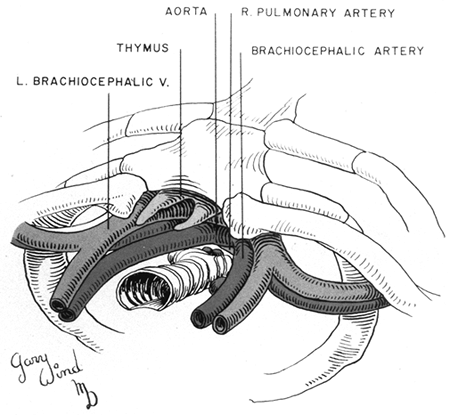 |
Fig. 161-1. Diagram of superior mediastinal structures shows the great vessels separating the anterior compartment (prevascular) containing the thymus and the visceral compartment (retrovascular) containing the trachea. |
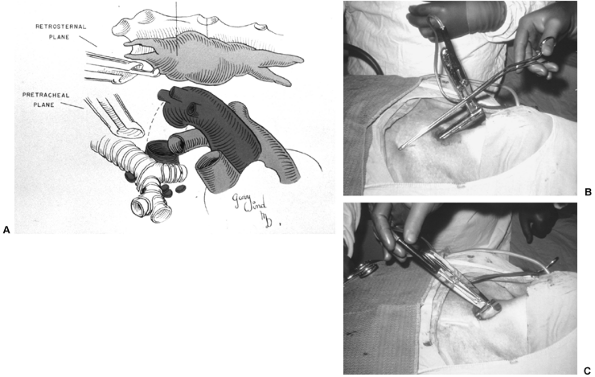 |
Fig. 161-2. A 34-year-old patient presented with a superior mediastinal tumor. Standard mediastinoscopy was negative, but extended substernal mediastinoscopy through the same incision yielded a diagnosis of malignant germ cell tumor. A. Schematic diagram of the superior portion of the mediastinum shows the separate access with the mediastinoscope into the anterior (prevascular) and visceral (retrovascular) compartments. Note the change in the angle of the mediastinoscope. B. Note the downward angle of the mediastinoscope in the visceral compartment. Biopsy here was negative. C. Note the horizontal disposition of the mediastinoscope in the anterior compartment. Biopsy here was positive. |
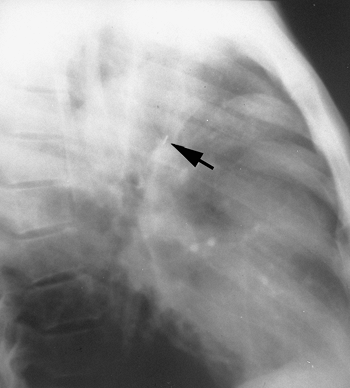 |
Fig. 161-3. A 61-year-old asymptomatic patient was found to have a large tumor in the mediastinal compartment on posteroanterior and lateral chest radiographs. At a standard Carlens' mediastinoscopy, which was carried down to the bifurcation of the trachea and marked by a metallic clip (arrow), no tumor was found. The postoperative lateral radiograph shows the metallic clip in the visceral compartment and the tumor in the anterior compartment. If a substernal prevascular mediastinoscopy had been done at the original procedure, the diagnosis would have been established readily. |
 |
Fig. 161-4. A 27-year-old patient had severe symptoms of cough, dyspnea, and respiratory distress. A computed tomographic scan with contrast clearly showed a huge prevascular tumor in the anterior compartment in front of the great vessels. At a Carlens' mediastinoscopy, performed elsewhere, no tumor was encountered, and no diagnosis was obtained. Subsequent median sternotomy was done with removal of a giant malignant germ cell tumor. Again, had the proper anatomic approach been done initially, the correct diagnosis would have been obtained. |
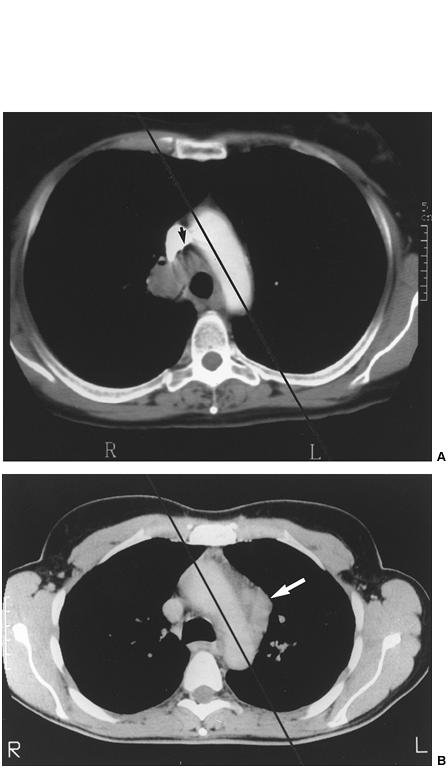 |
Fig. 161-5. A. Computed tomographic image showing lymphadenopathy (black arrow) in retrovascular plane accessible to standard cervical mediastinoscopy. B. Computed tomographic image shows lymphadenopathy (white arrow) in prevascular plane (aortopulmonary window) requiring access by extended mediastinoscopy or Chamberlain's procedure. From Kirschner PA: Cervical mediastinoscopy. Chest Surg Clin North Am 6:8, 1996. With permission. |
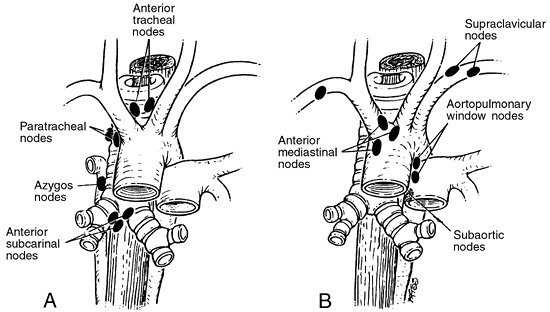 |
Fig. 161-6. A. Lymph nodes accessible to standard mediastinoscopy. B. Blind spots of classical mediastinoscopy requiring extended mediastinoscopy or Chamberlain's procedure. |
P.2448
REFERENCES
Carlens E: Mediastinoscopy a method for inspection and tissue biopsy in the superior mediastinum. Dis Chest 36:343, 1959.
Cooper JD, et al: An improved technique to facilitate transcervical thymectomy for myasthenia gravis. Ann Thorac Surg 45:242, 1988.
Kirschner PA: Cervical mediastinoscopy. Chest Surg Clin N Am 6:1, 1996.
Kirschner PA: Extended mediastinoscopy. Mediastinoscopy, Proceedings of an International Symposium, Odense University, June 18 20, 1970. Odense, Denmark: Odense University Press, 1971, p. 131.
Kirschner PA, Osserman, KE, Kark AE: Studies in myasthenia gravis: transcervical total thymectomy. JAMA 209:906, 1969.
McNeill TM, Chamberlain JM: Diagnostic anterior mediastinotomy. Ann Thorac Surg 2:532, 1966.
Metin M, et al: Extended cervical mediastinoscopy in the diagnosis of anterior mediastinal masses. Ann Thorac Surg 73:250, 2002.
EAN: 2147483647
Pages: 203